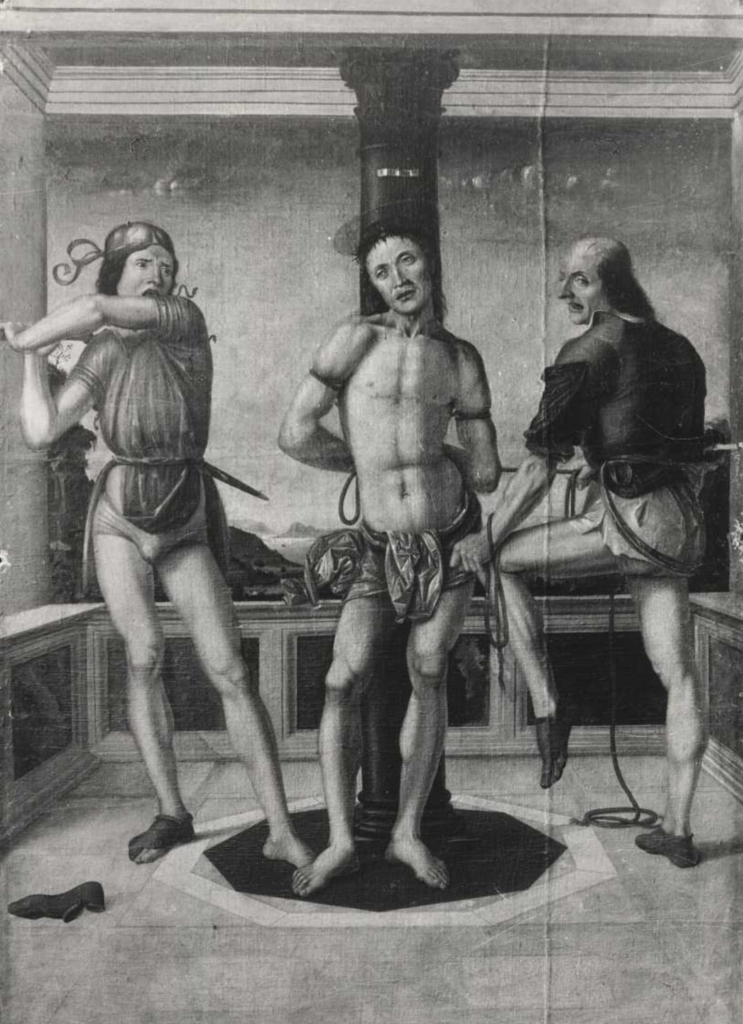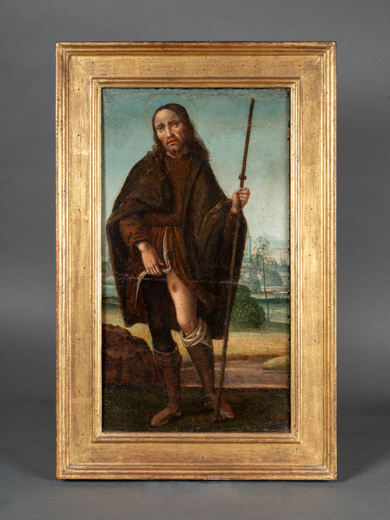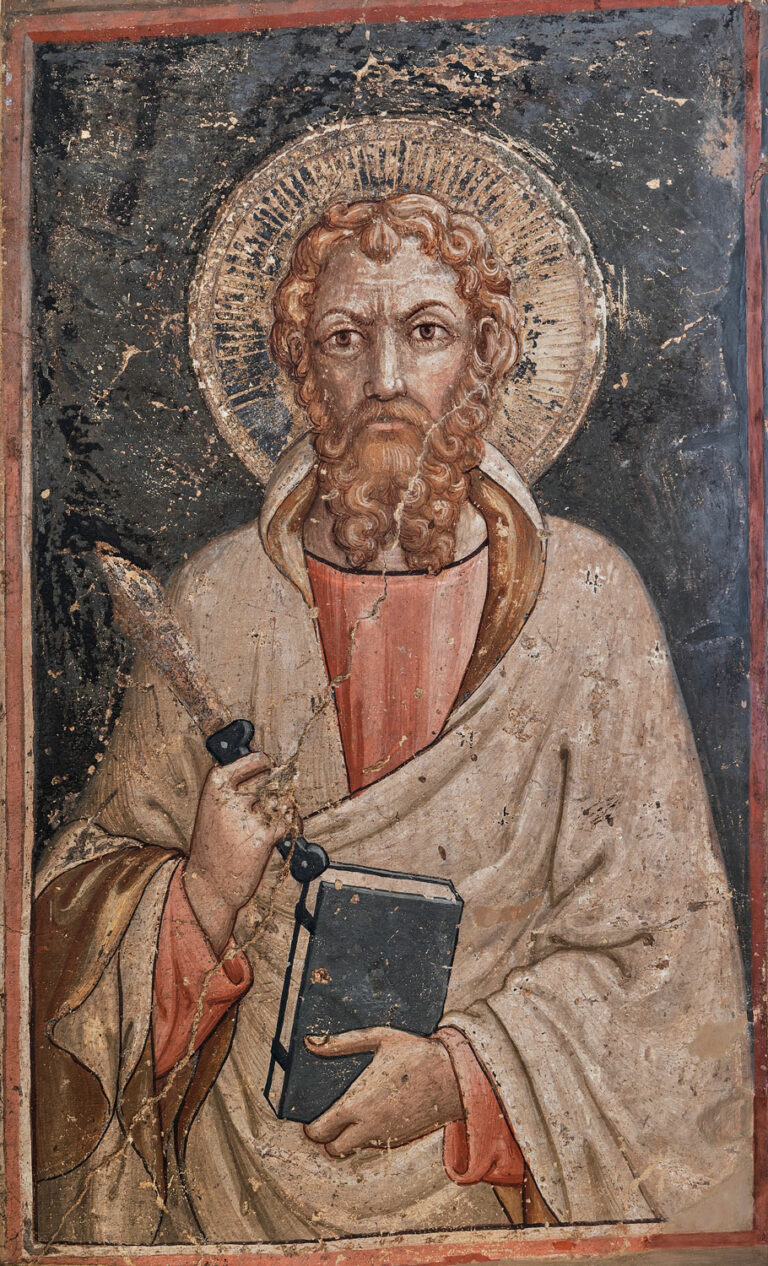Expertise et attribution par le Professeur Alessandro Del Priori
The small panel depicts Saint Roch standing in a landscape, his left hand holding a staff and his right hand lifting the hem of his garment to reveal the bare thigh and the plague wound. The reduced dimensions and proportions of the support suggest that the small painting may have originally been part of a larger complex. It could have been, for example, one of the figures on the side pillars of an altarpiece, perhaps in pendant with a similar Saint Sebastian.
The delicate landscape unfolding behind the saint is a beautiful step in painting, with details such as the slender tree on the riverbank, the bush whose foliage is caressed by the golden light, and the almost Flemish clarity of the city view, barely covered by a hint of bluish mist. All these details evoke the Umbrian world, balancing between the enthusiastic naturalism of Pintoricchio and the serene warmth of Perugino, with a nod to the early works of the young Raphael.
However, the saint’s face is sharply characterized, perhaps too strong to be aligned with the more classical Umbrian tradition. The high and bulging forehead, almost spherical, the smooth, metallic-like complexion, and the slightly frowning and sad expression recall Lombard painting between the 15th and 16th centuries, a blend of anti-classicism that informed a long line of painters from Leonardo to Perugino, from Bramantino to Johannes Hispanus, and even to the Veronese painters Giovanni Francesco Caroto, Domenico, and Francesco Morone.
The painting likely dates back to the late 15th or early 16th century, but stylistically, it appears isolated in both central and northern Italian contexts. However, there is a famous banner in Perugia, preserved in the Oratory of San Francesco, which culturally resonates well with our Saint Roch. It is a Flagellation of Christ in which the perspectival box staging the story is closely connected to the Pierfrancescan spaces, akin to the famous panels of 1473 depicting the stories of San Bernardino preserved in the National Gallery in Perugia.

The figures in this banner are expressive to the point of grotesque; one sees bloodshot eyes, crystal tears, and ropes cutting into Christ’s flesh. Yet, the painting is glossy and luminous, metallic reflections that even reverberate on every surface, from Christ’s statuesque body to the garments of the henchmen. Not surprisingly, Bramante, actually identified the painting with the one paid for in 1480 to Pietro di Galeotto, a student of Piero della Francesca. The artistic personality of the painter survives only through this image, as proposals to expand his catalog, though interesting, are not entirely convincing.
Tom Henry suggested associating this painter with the corpus of the Master of the Madonna Cini, who could indeed be confused with Piero at times but might be better understood as a very early phase of Luca Signorelli during his confirmed period in the workshop of the Borghiano. In essence, Pietro di Galeotto has only one painting from 1480. If we compare our Saint Roch, smaller in size and more subdued compared to the monumental rendering of the Perugian banner, it almost feels like breathing the same air, the same vein of Northern Italian Renaissance juxtaposed with Umbrian grace.
The same physiognomy of the saint’s face, with the necessary size differences, could be compared to that of Christ bound to the column. This proposal for further research will be crucial in defining the catalog and artistic personality of this painter, who is undeniably one of the most beautiful and singular figures in the Umbrian panorama of the late 15th century.
Bibliographie:
Expertise and attribution by Alessandro del Priori, Art historian and professor at University of Florence
- Bellosi L., Una « flagellazione » del Brabante a Perugia, in Prospettiva, 1977, pp. 61-68
- L. BELLOSI, Considerazio sulla mostra del Perugino, I, in « Prospettiva », 125, 2007, pp. 67-87, in part. pp. 75-78
- D. Franklin, The identity of a Perugian follower of Piero della Francesca, in The Burlington Magazine, CXXXV (1993), pp. 625-627
- U. Gnoli, Documenti inediti sui pittori perugini, in Bollettino d’arte, IX (1915), pp. 305-312
- T. HENRY, Perugino e Signorelli, in Pietro Vannucci, il Perugino, atti del convegno [Perugia 2000], a cura di L. Teza, Perugia 2004, pp. 75-89
- T. HENRY, La formazione di Pietro Perugino, in Perugino il divin pittore, cat. della mostra [Perugia 2004], a cura di F.F. Mancini e V. Garibaldi, Cinisello Balsamo 2004, pp. 73-79, in part, pp. 73-74.
- F.F. Mancini, Identificazione di Pietro di Galeotto, in « Esercizi Arte Musica Spettacolo », 2, 1979, pp. 43-55
- P. Scarpellini, Una postilla pierfrancescana. La scuola dell’artista tra settimo e ottavo decennio del Quattrocento, in Commentari d’arte, I (1995), pp. 21-28
- R. SILVESTRELLI, in Pintoricchio, cat della mostra Perugia 2008], a cura di V. Garibaldi, F.F. Mancini, Cinisello Balsamo 2008, cat. 17, pp. 200-201
- Todini F., La pittura umbra dal Duecento al primo Cinquecento, 1989, v. I p. 288, v. II figg. 1143-1144
- Garibaldi V./ Mancini F.F. (a cura di), Perugino il divin pittore, 2004, p. 206


